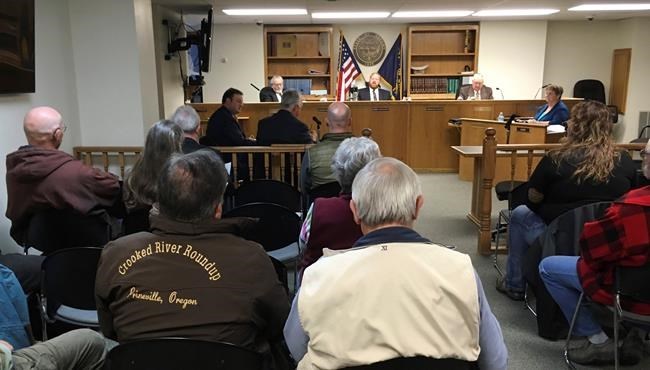
The Crook County commissioners hold a public meeting on Wednesday, Nov. 8, 2017, in Prineville, Ore. Crook County Commissioners unanimously adopted a land-use plan that says the county will participate fully in planning and decisions on federal lands that comprise about half of the county in central Oregon. (AP Photo/Andrew Selsky)
Republished November 09, 2017 - 5:14 PM
Original Publication Date November 09, 2017 - 2:51 PM
PRINEVILLE, Ore. - Encouraged by the Trump administration's pro-development policies, an Oregon county wants to take some control over federal lands that cover half of the high desert, mountains and forests within its borders.
The three-member Crook County Court governing body unanimously approved the Natural Resources Policy after a public meeting Wednesday in which people spoke passionately for and against the policy.
A sign at the building's entrance asked attendees to leave their weapons in their cars, and they were told by County Judge Seth Crawford to be respectful of each other. Crawford is the elected county administrator, not a courtroom judge.
The policy notes that "timber harvest, ranching, farming, and mining are the lifeblood of Crook County's economy" and that "humans are entitled to an equal opportunity to use federal and private lands for both recreation and economic growth."
At least two other counties — Owyhee County in Idaho and Baker County in Oregon — have enacted similar provisions.
The Crook County policy was drafted by a political action committee created by a group known as Central Oregon Patriots that backed Crawford in the election a year ago. His rival had opposed an earlier version of the land-use plan.
"This plan puts Crook County front and centre in an aggressive challenge of federal authority on public lands," said Sarah Cuddy, of the environmental group Oregon Wild who attended the meeting.
Patrick Lair, a spokesman for the Ochoco National Forest, said the Forest Service would have to wait and see how the county pursues the new policy. The county's opinions are valued but are just a part of federal considerations, he said.
"As a federal agency, we have obligations to take input from all citizens and stakeholders, not just those who live closest," Lair said.
The 1,330 square-mile (3,448 sq. kilometre) national forest features stands of majestic Ponderosa pines that were once used to feed five sawmills. All the mills were shuttered years ago as logging took a plunge.
County Commissioner Jerry Brummer said after the meeting that he believes the Trump administration will be receptive to the county's attempt to assert its authority in helping manage federal lands.
"We've got to go up the ladder. A lot of this is policy change," Brummer said.
Crook County Court previously considered the policy more than a year ago — before elections shifted the political landscape. Federal Bureau of Land Management district head Carol Benkosky warned it would create an adversarial relationship with federal agencies.
Since then, Wyoming lawyer Karen Budd-Falen, a key figure in the county supremacy movement, advised the county about modifying the plan.
Budd-Falen served on President Donald Trump's transition team and has been mentioned as a possible nominee to lead the Bureau of Land Management.
The movement that Budd-Falen has championed since the 1980s pushed to ensure federal land managers' plans were consistent with the "customs and cultures" of the counties in which the federal lands were located, said R. McGreggor Cawley, a professor of environmental politics and public administration at the University of Wyoming.
Opponents of the Crook County policy predicted federal agencies will ignore it, and they fear it could spark an armed takeover such as the one at Malheur National Wildlife Refuge two years ago.
Pete Sharp, a member of the Central Oregon Patriots and the political action committee that drafted the land-use plan, said his group is not a militia.
He said he believes in guns and agreed with those who occupied the wildlife refuge in an adjacent county for 41 days to protest federal land use policies. But Sharp said he wouldn't take up arms to push his agenda.
"I would not even think about that kind of thing," Sharp, 74, said in an interview, wearing a black leather vest over a red shirt and cowboy hat and boots. He said elections were a more productive and less disruptive way to achieve goals.
Chris Scranton held a sign during the meeting that said, "I love public land." He said he believes the local PAC "has the same motivations and goals as the ... Malheur occupiers although their tactics are different."
The people behind the new policy "do not believe people like me who are not extracting resources but instead are birding, hunting, fishing, flower-sniffing etc. have the same rights to the land as they do," Scranton said in an email.
Opponents also noted the Ochoco Forest Restoration Collaborative, with a wide variety of stakeholders, already works with federal officials about land management.
Steve Forrester, who had a career in forestry products and is now city manager of Prineville, the county seat, said he favours the new policy.
"If you don't communicate and educate, you're going to get run over," he said outside the hearing room.
The new policy takes effect in 120 days.
___
Follow Andrew Selsky on Twitter at http://twitter.com/andrewselsky
News from © The Associated Press, 2017